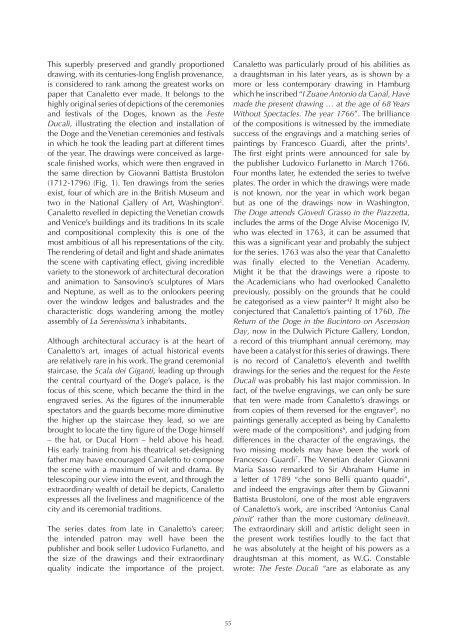XV - Works On Paper - Marty de Cambiaire (English)
Create successful ePaper yourself
Turn your PDF publications into a flip-book with our unique Google optimized e-Paper software.
This superbly preserved and grandly proportioned<br />
drawing, with its centuries-long <strong>English</strong> provenance,<br />
is consi<strong>de</strong>red to rank among the greatest works on<br />
paper that Canaletto ever ma<strong>de</strong>. It belongs to the<br />
highly original series of <strong>de</strong>pictions of the ceremonies<br />
and festivals of the Doges, known as the Feste<br />
Ducali, illustrating the election and installation of<br />
the Doge and the Venetian ceremonies and festivals<br />
in which he took the leading part at different times<br />
of the year. The drawings were conceived as largescale<br />
finished works, which were then engraved in<br />
the same direction by Giovanni Battista Brustolon<br />
(1712-1796) (Fig. 1). Ten drawings from the series<br />
exist, four of which are in the British Museum and<br />
two in the National Gallery of Art, Washington 2 .<br />
Canaletto revelled in <strong>de</strong>picting the Venetian crowds<br />
and Venice’s buildings and its traditions In its scale<br />
and compositional complexity this is one of the<br />
most ambitious of all his representations of the city.<br />
The ren<strong>de</strong>ring of <strong>de</strong>tail and light and sha<strong>de</strong> animates<br />
the scene with captivating effect, giving incredible<br />
variety to the stonework of architectural <strong>de</strong>coration<br />
and animation to Sansovino’s sculptures of Mars<br />
and Neptune, as well as to the onlookers peering<br />
over the window ledges and balustra<strong>de</strong>s and the<br />
characteristic dogs wan<strong>de</strong>ring among the motley<br />
assembly of La Serenissima’s inhabitants.<br />
Although architectural accuracy is at the heart of<br />
Canaletto’s art, images of actual historical events<br />
are relatively rare in his work. The grand ceremonial<br />
staircase, the Scala <strong>de</strong>i Giganti, leading up through<br />
the central courtyard of the Doge’s palace, is the<br />
focus of this scene, which became the third in the<br />
engraved series. As the figures of the innumerable<br />
spectators and the guards become more diminutive<br />
the higher up the staircase they lead, so we are<br />
brought to locate the tiny figure of the Doge himself<br />
– the hat, or Ducal Horn – held above his head.<br />
His early training from his theatrical set-<strong>de</strong>signing<br />
father may have encouraged Canaletto to compose<br />
the scene with a maximum of wit and drama. By<br />
telescoping our view into the event, and through the<br />
extraordinary wealth of <strong>de</strong>tail he <strong>de</strong>picts, Canaletto<br />
expresses all the liveliness and magnificence of the<br />
city and its ceremonial traditions.<br />
The series dates from late in Canaletto’s career;<br />
the inten<strong>de</strong>d patron may well have been the<br />
publisher and book seller Ludovico Furlanetto, and<br />
the size of the drawings and their extraordinary<br />
quality indicate the importance of the project.<br />
Canaletto was particularly proud of his abilities as<br />
a draughtsman in his later years, as is shown by a<br />
more or less contemporary drawing in Hamburg<br />
which he inscribed “I Zuane Antonio da Canal, Have<br />
ma<strong>de</strong> the present drawing … at the age of 68 Years<br />
Without Spectacles. The year 1766”. The brilliance<br />
of the compositions is witnessed by the immediate<br />
success of the engravings and a matching series of<br />
paintings by Francesco Guardi, after the prints 3 .<br />
The first eight prints were announced for sale by<br />
the publisher Ludovico Furlanetto in March 1766.<br />
Four months later, he exten<strong>de</strong>d the series to twelve<br />
plates. The or<strong>de</strong>r in which the drawings were ma<strong>de</strong><br />
is not known, nor the year in which work began<br />
but as one of the drawings now in Washington,<br />
The Doge attends Giovedi Grasso in the Piazzetta,<br />
inclu<strong>de</strong>s the arms of the Doge Alvise Mocenigo IV,<br />
who was elected in 1763, it can be assumed that<br />
this was a significant year and probably the subject<br />
for the series. 1763 was also the year that Canaletto<br />
was finally elected to the Venetian Aca<strong>de</strong>my.<br />
Might it be that the drawings were a riposte to<br />
the Aca<strong>de</strong>micians who had overlooked Canaletto<br />
previously, possibly on the grounds that he could<br />
be categorised as a view painter 4 ? It might also be<br />
conjectured that Canaletto’s painting of 1760, The<br />
Return of the Doge in the Bucintoro on Ascension<br />
Day, now in the Dulwich Picture Gallery, London,<br />
a record of this triumphant annual ceremony, may<br />
have been a catalyst for this series of drawings. There<br />
is no record of Canaletto’s eleventh and twelfth<br />
drawings for the series and the request for the Feste<br />
Ducali was probably his last major commission. In<br />
fact, of the twelve engravings, we can only be sure<br />
that ten were ma<strong>de</strong> from Canaletto’s drawings or<br />
from copies of them reversed for the engraver 5 , no<br />
paintings generally accepted as being by Canaletto<br />
were ma<strong>de</strong> of the compositions 6 , and judging from<br />
differences in the character of the engravings, the<br />
two missing mo<strong>de</strong>ls may have been the work of<br />
Francesco Guardi 7 . The Venetian <strong>de</strong>aler Giovanni<br />
Maria Sasso remarked to Sir Abraham Hume in<br />
a letter of 1789 “che sono Belli quanto quadri”,<br />
and in<strong>de</strong>ed the engravings after them by Giovanni<br />
Battista Brustoloni, one of the most able engravers<br />
of Canaletto’s work, are inscribed ‘Antonius Canal<br />
pinxit’ rather than the more customary <strong>de</strong>lineavit.<br />
The extraordinary skill and artistic <strong>de</strong>light seen in<br />
the present work testifies loudly to the fact that<br />
he was absolutely at the height of his powers as a<br />
draughtsman at this moment, as W.G. Constable<br />
wrote: The Feste Ducali “are as elaborate as any<br />
55
















